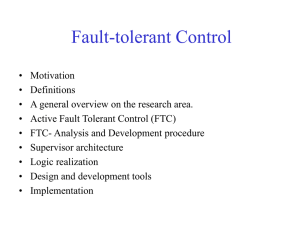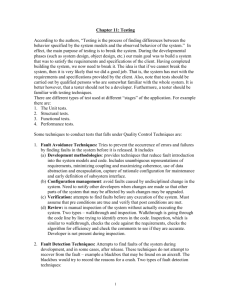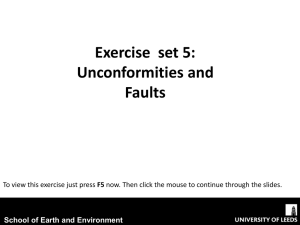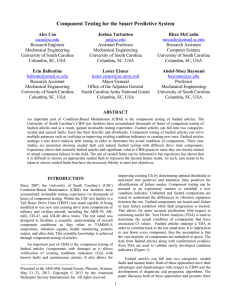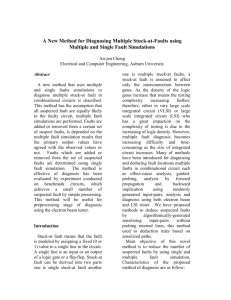Testcoverage
advertisement
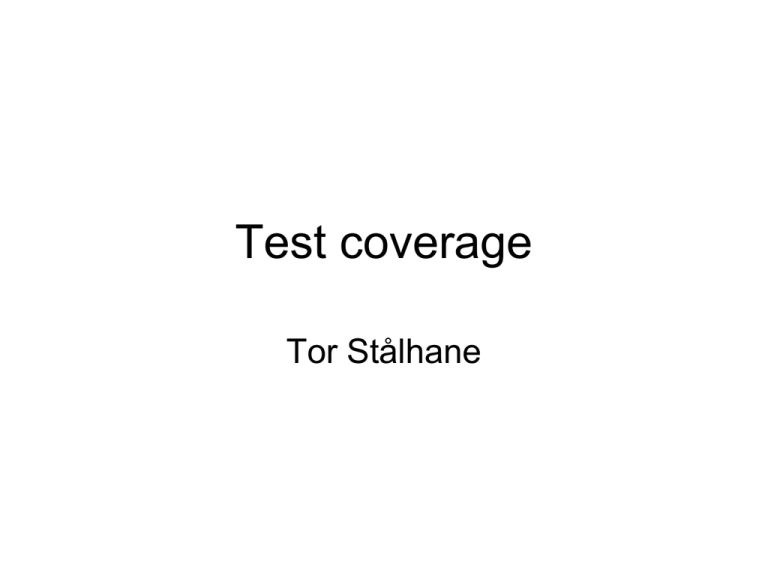
Test coverage
Tor Stålhane
What is test coverage
Let c denote the unit type that is considered
– e.g. requirements or statements. We
then have
Cc = (unitsc tested) / (number of unitsc)
Coverage categories
Broadly speaking, there are two categories
of test coverage:
• Program based coverage. This category is
concerned with coverage related to the
software code.
• Specification based coverage. This
category is concerned with coverage
related to specification or requirements
Test coverage
For software code, we have three basic
types of test coverage:
• Statement coverage – percentage of
statements tested.
• Branch coverage – percentage of
branches tested.
• Basic path coverage – percentage of basic
paths tested.
Finite applicability – 1
That a test criterion has finite applicability
means that it can be satisfied by a finite
test set.
In the general case, the test criteria that we
will discuss are not finitely applicable. The
main reason for this is the possibility of
“dead code” – e.g infeasible branches.
Finite applicability – 2
We will make the test coverage criteria that
we use finitely applicable by relating them
to only feasible code.
Thus, when we later speak of all branches
or all code statements, we will tacitly
interpret this as all “feasible branches” or
all “feasible code”.
Statement coverage
This is the simplest coverage measure:
Cstat = percentage of statements tested
Path diagram
P1
S1
<empty>
P2
S2
<empty>
P3
S3
<empty>
S4
Predicates
P1
P2
0
0
0
0
0
1
0
1
1
0
1
0
1
1
1
1
P3
0
1
0
1
0
1
0
1
Paths
S4
S3, S4
S2, S4
S2, S3, S4
S1, S4
S1, S3, S4
S1, S2, S4
S1, S2, S3, S4
Branch coverage
Branch coverage tells us how many of the
possible paths that has been tested.
Cbranch = percentage of branches tested
Basis path coverage
The basis set of paths is the smallest set of
paths that can be combined to create
every other path through the code.
The size of this set is equal to v(G) –
McCabe’s cyclomatic number.
Cbasis = percentage of basis paths tested
Use of test coverage
There are several ways to use the coverage
values. We will look at two of them
coverage used
• As a test acceptance criteria
• For estimation of one or more quality
factors, e.g. reliability
Test acceptance criteria
At a high level this is a simple acceptance
criterion:
• Run a test suite.
• Have we reached our acceptance criteria
– e.g. 95% branch coverage?
– Yes – stop testing
– No – write more tests. If we have tool that
shows us what has not been tested, this will
help us in selecting the new test cases.
Avoid redundancy
If we use a test coverage measure as an
acceptance criterion, we will only get credit
for tests that exercise new parts of the
code.
In this way, a test coverage measure will
help us to
• Directly identify untested code
• Indirectly help us to identify new test cases
Fault seeding – 1
The concept “fault seeding” is used as
follows:
• Insert a set of faults into the code
• Run the current test set
• One out of two things can happen:
– All seeded faults are discovered, causing
observable errors
– One or more seeded faults are not discovered
Fault seeding – 2
The fact that one or more seeded errors are
not found by the current test set tells us
which parts of the code that have not yet
been tested – e.g. which component, code
chunk or domain.
This info will help us to define the new test
cases.
Fault seeding – 3
Fault seeding has one problem – where and
how to seed the faults.
There are at least two solutions to this:
• Save and seed faults identified during
earlier project activities
• Draw faults to seed from an experience
database containing typical faults and their
position in the code.
Fault seeding and estimation – 1
Seeded
fault
X
X
Test
domain
X
X
X
X
Real
fault
X
X
Input
domain
Fault seeding and estimation – 2
We will use the following notation:
• N0: number of faults in the code
• N: number of faults found using a specified
test set
• S0: number of seeded faults
• S: number of seeded faults found using a
specified test set
Fault seeding and estimation – 3
Seeded
fault
X
Test
domain
X
X
X
Real
fault
X
X
X
X
Input
domain
N0 / N = S0 / S
and thus
N 0 = N * S0 / S
or
N0 = N * S0 / max{S, 0.5}
Capture – recapture
One way to get around the problem of fault
seeding is to use whatever errors are
found in a capture – recapture model.
This model requires that we use two test
groups.
• The first group finds M errors
• The second group finds n errors
• m defects are in both groups
m / n = M / N => N = Mn / m
Capture – recapture
No Customer 1 Customer 2
Common
N
1
25
36
17
52
2
29
30
11
79
3
23
21
13
37
4
0-1
0-2
0
0-4
Output coverage – 1
All the coverage types that we have looked
at so far have been related to input data.
It is also possible to define coverage based
on output data. The idea is as follows:
• Identify all output specifications
• Run the current test set
• One out of two things can happen:
– All types of output has been generated
– One or more types of output have not been
generated
Output coverage – 2
The fact that one or more types of output
has not been generated by the current test
set tells us which parts of the code that
have not yet been tested – e.g. which
component, code chunk or domain.
This info will help us to define the new test
cases.
Output coverage – 3
The main challenge with using this type of
coverage measure is that output can be
defined at several levels of details, e.g.:
• An account summary
• An account summary for a special type of
customer
• An account summary for a special event –
e.g. overdraft
Specification based coverage – 1
Specification based test coverage is in most
cases requirements based test coverage.
We face the same type of problem here as
we do for output coverage – the level of
details considered in the requirements.
In many cases, we do not even have a
detailed list of requirements. This is for
instance the case for user stories
frequently used in agile development.
Specification based coverage – 2
The situation where this is most easy is for
systems where there exist a detailed
specification, e.g. as a set of textual use
cases.
Use case name
(Re-)Schedule train
Use case actor
Control central operator
User action
System action
1. Request to enter schedule info
2. Show the scheduling
screen
3. Enter the schedule (train-ID, start
and stop place and time, as well
as timing for intermediate points)
4 Check that the schedule
does not conflict with other
existing schedules; display
entered schedule for
confirmation
5. Confirm schedule
Quality factor estimation
The value of the coverage achieved can be
used to estimate important quality
characteristics like
• Number of remaining fault
• Extra test time needed to achieve a certain
number of remaining faults
• System reliability
Basic assumptions
In order to use a test coverage value to
estimate the number of remaining faults,
we need to assume that:
• All faults are counted only once.
• Each fault will only give rise to one error
• All test case have the same size
Choice of models – errors
We will use the notation
• N(n): number of errors reported after n
executions
• N0: initial number of faults
There exists more than a dozen models for
N(n) = f(N0, n, Q). It can be shown that when
we have N(n) -> N0, we have
N(n) = N0(1 – exp(-Qn)]
Choice of models – coverage (1)
We will use the notation
• C(n): the coverage achieved after n tests
• C0: final coverage. We will assume this to
be 1 – no “dead” code.
Further more, we will assume that
C(n) = 1 / [1 + A exp( – an)]
Choice of models – coverage (2)
C(n)
1
1 / (1 + A)
n
Parameters
We need the following parameters:
• For the N(n) model we need
– N0: total number of defects
Q: mean number of tests to find a defect
• For the C(n) model we need
– A: first test coverage
– a: coverage growth parameter
All four parameters can be estimated from
observations using the Log Likelihood
estimator.
Final model
We can use the C(n) expression to get an
expression for n as a function of C(n).
By substituting this into the N(n) expression
we get an estimate for the number of
remaining fault as a function of the
coverage:
N 0 N (n) 1 C (n)
N0
AC
(
n
)
Q
a






